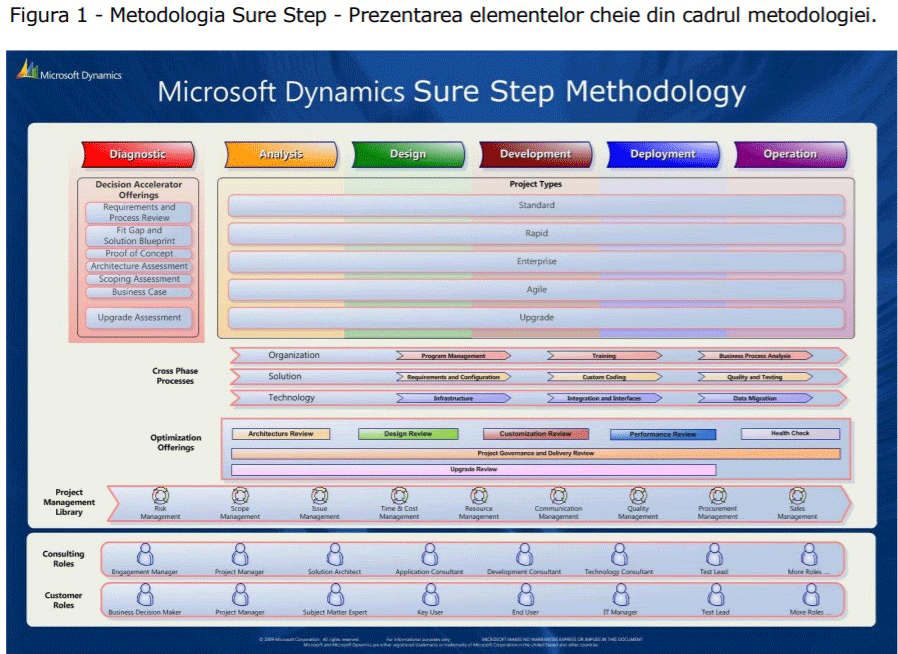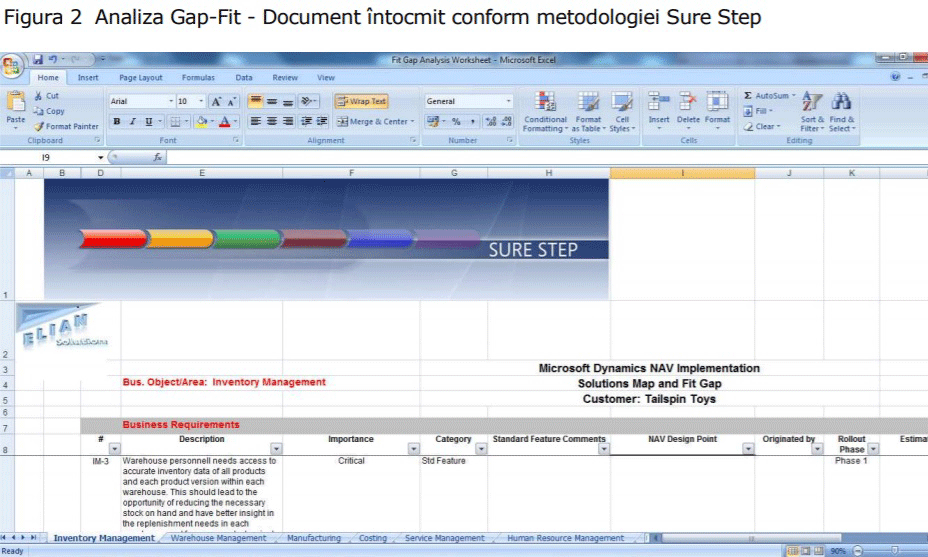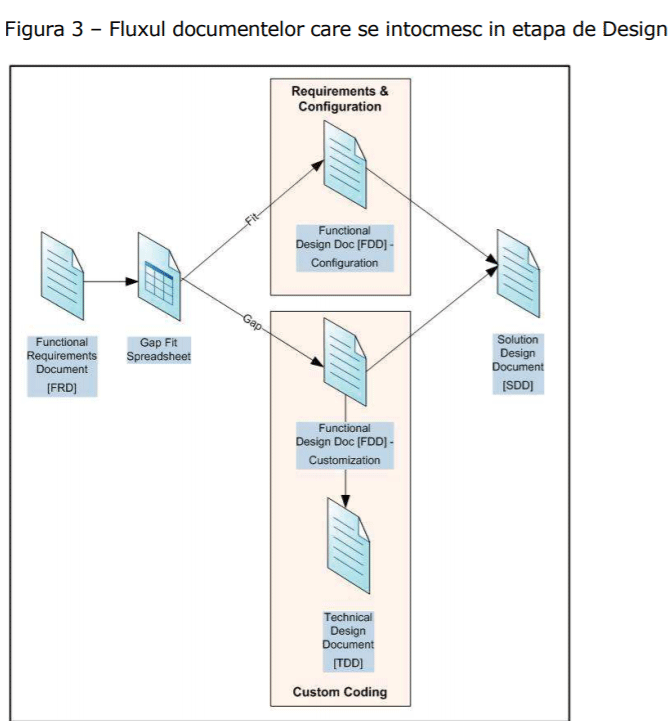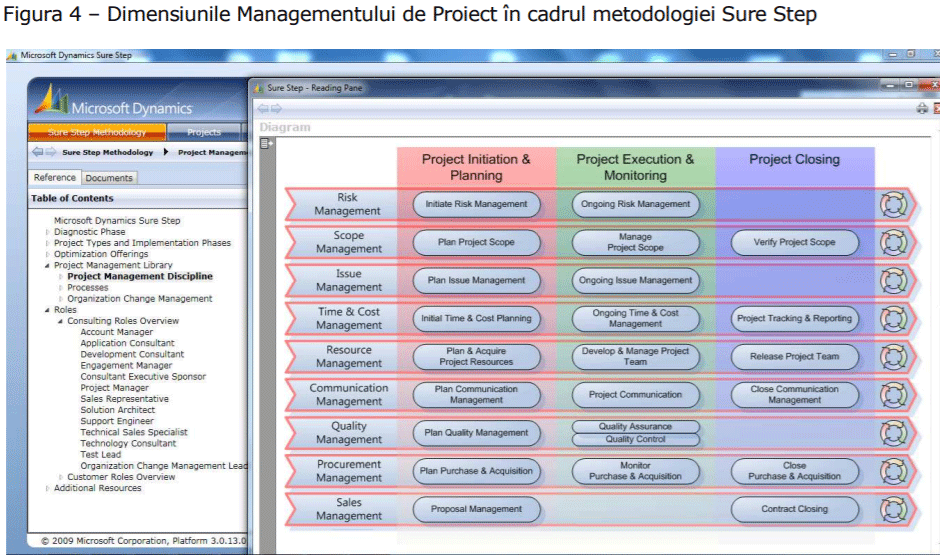Sure Step implementation methodology for Microsoft ERP and CRM solutions
This article aims to provide an introduction to the methodology called “Sure Step”, a methodology created and promoted by Microsoft to help implement the ERP and CRM solutions that Microsoft sells (Microsoft Dynamics solutions). It is addressed to all those interested in managing an ERP or CRM solution implementation, who want to know the necessary actions for a quality implementation.
The implementation of an ERP solution cannot be achieved without professional project management and an intense organisational effort from both the implementer and the client.
The ELIAN Solutions team, which implements the Microsoft Dynamics NAV solution, has fully adopted this implementation methodology, convinced that the best practices included in it are a guarantee of the success of any implementation.
Solution – Sure Step methodology developed by Microsoft
Implementing an ERP solution can be difficult, much more difficult than the customer and the implementer expect. The result does not match the initial estimates. Why? Because the complexity of the approach is not taken into account and there are gaps in the way implementation is organised. Management skills differ from implementer to implementer and from client to client.
Microsoft, which sells several ERP and CRM solutions, is aware of this shortcoming and decided to help partners – those who implement the solutions – by promoting (and imposing) an implementation methodology that provides support to implementers.
The methodology provides them with a set of tools designed to help with project management and also to give clients confidence in the quality of implementation.
The methodology is contained in a software package that can be installed either on a workstation or on a network, through integration with SharePoint technology.
Sure Step Methodology – The phases Within the Sure Step model, 6 stages of an implementation are defined: Diagnostic, Analysis, Design, Development, Installation, Operational.of an Implementation
Within the Sure Step model, 6 phases of an implementation are defined: Diagnostic, Analysis, Design, Development, Installation, Operational.
Diagnostic phase
The diagnostic phase is a stage that takes place before the actual implementation. It starts during the sales process and ends with an Implementation Plan (Project Plan). If the customer accepts the Project Plan, then implementation takes place.
The purpose of this phase is to gather enough information to define the scope of the project and to make an implementation proposal that meets the client’s expectations.
During this phase there are actions such as:
- Identify and define the scope of the project;
- Guiding the client to the type of project and implementation appropriate to its needs;
- Estimating the costs and the project schedule;
- Planning the resources allocated to the project;
Risk estimation; - Creating a Project Plan.

In order for the implementer to make an offer as close to the truth as possible, a preliminary analysis of the client’s business needs is necessary. Meetings between the implementer’s consulting team and the potential client’s key users can take place at this stage to gather data about the client’s current situation.
The meetings result in documents that can be used later during implementation. At this stage they are only intended to clarify the client’s business requirements and to instil confidence in the client in the capabilities of the solution.
Analysis Phase
If the client accepts the Project Plan, the implementation starts. The analysis phase is the beginning of the implementation and the most important one. In this phase meetings are organised between the client’s key users and the implementation consultants to identify and document the client’s business requirements.
The Sure Step methodology indicates for this stage several types of documents that can be prepared but the most important (and mandatory) are:
Functional Requirements Document (FRD)
Gap-Fit Analysis Document (Gap-Fit Analysis)
Functional Requirements Document
The purpose of this document is to identify all of the customer’s functional requirements. The functional requirement is in fact what the customer expects the solution to achieve to support their business processes. For example, the customer needs to follow the procurement process in the system, starting with the registration of offers from suppliers, through the placing of orders and ending with the receipt and invoicing of purchased items.
Functional requirements are documented in detail to determine clearly:
- Current processes that are desired to be retained in the new system – as they are in the old system;
- Processes that need to be changed or new processes that need to be supported by the solution.
Gap-Fit analysis document
The Gap-Fit analysis document is usually produced in Excel and is structured by functional areas (Financial, Procurement, Sales, Production, etc.) The role of this document is to clearly qualify the functional requirements that are solved by the standard system versus those that require developments in the system.
Each requirement is numbered, classified in terms of importance and also categorised as Fit (no development required) or Gap (development required).
Also in this document, information detailing how the functional requirement will be solved is passed. The information will be useful for configuring the system or for making developments.
Design phase
The purpose of this stage is to define how the customer’s functional requirements will be implemented in the new system. This stage includes activities such as:
- Configuration of the Dynamics NAV application according to the customer’s functional requirements. For example, defining the grouping of customers and suppliers according to customer criteria, setting up numeric series, defining users and their access rights in the system, etc. These configurations are documented in the “Functional Design Document for Fits-Configurations”;
- The design of customer specific developments which involves:
- Design by consultant – details the development from a functional point of view and is written in terms of business language. The result is the “Functional Design Document Customizations”.
- Developer’s design – details the development from a technical point of view. The “Technical Design Document” is obtained.
As the creation of 3 different documents can fragment the overall vision of the solution to be delivered to the customer, after the creation of the 3 documents it is recommended to create a document that describes the overall solution for the customer’s business requirements in a language the customer understands. This results in the “Solution Design Document”.
Development phase
In the development stage, customer-specific adaptations/developments are made as defined and approved in the design specifications. In this stage activities are carried out, such as:
- Development and testing of developments (by developers and consultants);
- Integrations and interfaces;
- Data migration processes;
- Development of test scenarios for end users.
The creation of test scripts is very important, as users will validate that the developments meet the functional requirements documented in the previous steps. The test scripts include the performance of some common operations, such as:
- Creation of entities in the system (customers, suppliers, accounting accounts);
- Entering documents (orders, invoices, receipts, consumption) or
- Running reports.
Installation phase
This stage includes all the activities necessary for the system to be installed at the customer’s site and become operational, i.e. the customer can actually work with the system.
The installation is based on a Deployment Plan that documents actions such as:
- Parameterization of the working environment;
- Data migration;
- Parameterization of users;
- End-user training;
- Application deployment strategies (multi-stage, multi-location, etc.).
The Installation Plan also provides a timetable for each operation, as well as the resources that are allocated to carry out the activities.
Operational Phase
This stage includes the actions required to close the project and transfer both the solution and the knowledge about the solution to the customer. It involves performing activities such as:
- Completion of open issues;
- Providing support as soon as the system is operational (post Go-Live);
- Completion of knowledge transfer from the implementation team to the users;
- Carrying out performance tests and system optimizations;
- Establishing quality assurance strategies during the actual working period with the system;
- Documenting lessons learned during implementation – for use in future implementations;
- Transition to the post-implementation support period.
In this last step, the “Project Closeout Report” document is drafted in order to verify and validate the results of the project, as well as to obtain formal acceptance from the client on the implementation.
Project Management
The implementation process requires effective project management. In this respect, the Sure Step methodology provides a set of recommendations for project management and at the same time delivers a set of documents that can be used (with implementation-specific adaptations) for project management.
The activities involved in project management take place throughout all stages of implementation.
Consider the dimensions of project management in the figure below.
Risk Management
It involves the identification and analysis of risks as well as actions to prevent them. Risk is a future and uncertain event that may have an impact on the implementation objectives in terms of cost, proposed timing or quality of implementation.
Risks can be recorded and tracked in a document written in Excel, called the Risk Register. In this document each risk is recorded; it is given a numerical code, a description of the risk, an assessment of the probability of occurrence, the category to which it belongs, the impact of its occurrence, the person responsible, etc.
Risks are analysed during the regular project status meetings. They are included in a section of the Project Status Report.
Project Scope Management
It aims to define and control what is included in the project and what is outside the project. It is necessary to define very clearly from the outset the functional areas included in the project. For this reason, the Project Plan mentions not only what will be done in the project but also what will not be done in the project.
However, some changes in business requirements may occur during implementation and these need to be monitored and evaluated.
The change requirements are documented by means of the “Change Request” document. It is very important to assess the impact of the Change Request on the project. Too many requirements that arise after the Project Plan may compromise the implementation.
Issue Management
It involves solving problems that arise during an implementation and that may affect the implementation. Problems are identified, documented and resolved.
Each issue is documented using an Issue Form.
This form assigns a unique problem code, describes the problem, assesses the severity, assigns a responsible person, sets a deadline for resolution, etc.
To get an overview, the “Issue list” document is used to centralise issues and make it easier to monitor them.
It involves solving problems that arise during an implementation and that may affect the implementation. Problems are identified, documented and resolved.
Each issue is documented using an Issue Form. This form assigns a unique problem code, describes the problem, assesses the severity, assigns a responsible person, sets a deadline for resolution, etc.
To get an overview, the “Issue list” document is used to centralise issues and make it easier to monitor them.
Time and Cost Management
Ensures, controls and manages time and cost so that the project is completed within the time and cost agreed with the client.
Time and cost are initially estimated during the Diagnostic phase when the Project Plan is produced. The WBS (Work Breakdown Structure) method can be used to estimate. Define the deliverables to be achieved in the Project on a tree structure – from the general to the more detailed. On the last level the estimated resource consumption is entered and the total cost of the project is obtained by aggregation.
During the implementation it is necessary to monitor the activities within the established time and cost parameters.
Resource Management
Organize and manage all resources involved in the project; people, equipment, other material resources.
Special attention is given to human resources. In order to properly manage human resources, the roles that are needed to carry out the project are first determined and the activities in the Project Plan are associated to the roles.
Each human resource may have one or more roles. Roles define a person’s skills and responsibilities in the project – both on the implementer’s and client’s side. Examples of roles: Project Manager, Application Consultant, Lead User, IT Manager, etc.
Communication Management
Deals with the creation, distribution, retrieval and storage of project information to meet the information needs – related to implementation – of the project team and the client.
The implementation of communication management is defined in a “Communication Plan” which sets out the types of communication, methods of communication, frequency of communication, responsible person, list of contacts, escalation paths, etc.
Quality Management
Ensures a certain level of quality for the implementation documentation and for the implementation itself. Quality management includes activities such as process definition, development of procedures, standards and policies aimed at meeting the customer’s expectations regarding the quality of implementation services. For example, the development of documents such as the “Testing Plan” or the “Training Plan” are considered as part of the project quality management.
Procurement Management
Manages the procurement of goods and services that are necessary to carry out the implementation but are delivered by third parties. It is critical that these procurements are planned from the start of the project so as not to affect the project timeline. Subcontracting of some actions in the Project Plan creates additional risks for the project and therefore monitoring of the subcontractors’ activity is also necessary.
Sales Management
It involves coordinating activities with the sales team, during the Diagnostic stage, to provide the client with a Project Plan containing the most accurate cost estimate of an implementation, and covering the client’s business requirements. The need for such an approach becomes even more important in complex implementations, where the skills of the consulting team are critical to determine an accurate Project Plan.
Conclusion
The Sure step method gives partners and clients the certainty of a successful implementation by providing project managers with adequate tools for planning, monitoring and control. Each phase of the implementation is documented – to get a clear picture of both the business requirements and the solutions to these requirements.
The methodology provides a wealth of guidance, synthesising best practice in implementation and project management. Various document templates are available, and project managers can choose them according to the complexity of the project.
The ELIAN Solutions team, by adopting this methodology, wants to offer its clients the guarantee of a successful implementation, which will bring the expected benefits.







